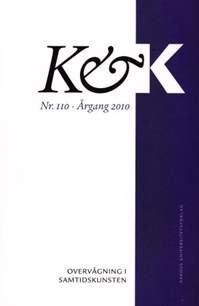OVERVÅGNING SOM LOVGIVNING - HASAN ELAHI OG SURVEILLANCE CAMERA PLAYERS SOM EKSEMPEL
DOI:
https://doi.org/10.7146/kok.v38i110.15778Keywords:
overvågning, lov, Elahi, Deleuze, Catá BackerAbstract
SURVEILLANCE AS LAW. CASE-STUDIES OF HASAN ELAHI AND THE SURVEILLANCE CAMERA PLAYERSThis article traces sousveillance strategies in two pieces of contemporary art, namely in Hasan Elahi’s Tracking Transience (2002), and 1984 by The Surveillance Camera Players. It discusses the ways that contemporary art reflects surveillance in an ironic and metareflective way. The article is based on the idea that the conditions for understanding the logics of surveillance have changed since World War II. It takes its point of departure in Gilles Deleuze’s proposition that we live in post-disciplinarian societies and that contemporary surveillance should be understood not according to the logic of the panopticon but according to the logic of a coded ‘control society’ based on modulations. It also follows the idea, proposed by Larry Catá Backer that surveillance not only is a phenomenon facilitated by law but is also a phenomenon that creates its own law and regulation.
Downloads
Published
2010-12-29
How to Cite
Simonsen, K.-M. (2010). OVERVÅGNING SOM LOVGIVNING - HASAN ELAHI OG SURVEILLANCE CAMERA PLAYERS SOM EKSEMPEL. K&K - Kultur Og Klasse, 38(110), 129–146. https://doi.org/10.7146/kok.v38i110.15778
Issue
Section
Articles
License
Tidsskriftet følger dansk ophavsret.





